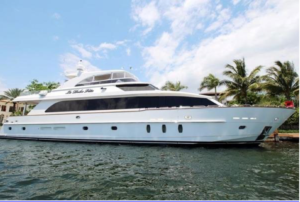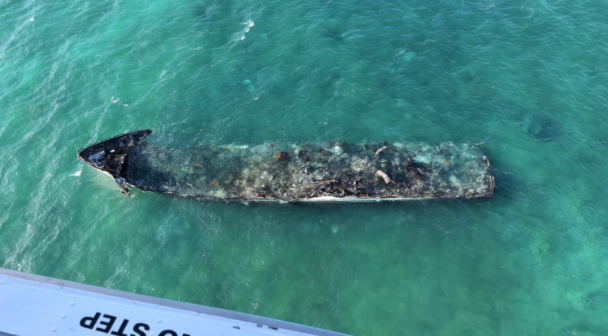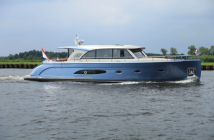About 1 in the afternoon of March 16, 2001, the 100-foot yacht La Dolce Vita anchored near the largest islet in the Marquesas, the start of a four-day charter from Key West, just 17 miles away, with four crew and two guests on board.
Everything was fine until about 5:30, when the mate smelled something; a fire had started in the engine room. Despite the captain’s efforts to fight it, first with dry chemical extinguishers and then with the boat’s own fire-suppression system, the entire yacht caught fire; it sank the next day, a $3.9 million total loss. Fortunately all six people got off safely in the tender and were picked up by the Coast Guard.
But what could go so wrong, so fast?
Now, the National Transportation Safety Board has issued a report of its investigation, finding that the fire probably started from an electrical source in the sound enclosure for the starboard generator, and it spread because of the inability to secure ventilation to the engine room.
La Dolce Vita was built by Hargrave Custom Yachts in Taiwan in 2008. A luxury motoryacht, It had three decks, displaced 216 tons, and was powered by twin 1,675-hp Cats. Recently, it has been chartered four to six times a year.

The NTSB report says that about 5:30 on the afternoon of the fire, the mate was in the main cabin and smelled something “like plastic was burning” and went to the engine room to investigate.
Both generators were running, since the yacht was an anchor. The mate saw smoke coming from the sound-deadening enclosure that surrounded the starboard generator. He closed the engine-room door and went to get the captain.
As it happened, the captain was already heading aft to prepare for a snorkeling expedition, and he saw smoke through a salon window. He ran into the mate coming back from the engine room. When the captain opened the engine-room door, the report says, he saw “smoke billowing out and flames coming out of the starboard generator.” He told the mate to get the fire extinguishers.
The mate returned with three dry-chemical extinguishers The captain reached the cutoff switches for both generators and shut them down. He fired all three extinguishers into the engine room and shut the door.
The captain then looked into the engine room through a small access and was distressed to see that the extinguishers had no effect. He told the mate to gather everyone together and get the tender ready.
The report says the captain then pulled the plunger to activate the yacht’s fixed fire-suppression system in the engine room, and he went up to the bridge to call the Key West Coast Guard to report that the yacht was on fire and he needed help. He told the passengers to go aft to the tender and abandon ship.
Everyone, except the captain, put on life jackets and climbed in the tender. He made one last trip to the engine room to fire one last dry-chemical extinguisher. The NTSB report said the captain described the smell there “like insulation burning off of electrical wires,” and not like a fuel-fed fire.
The captain then joined the other five people in the tender and the moved a safe distance away from the flames and dark back smoke coming from the burning yacht. Two Coast Guard vessels arrived quickly and took everyone back to Key West; no one was injured.
The boat burned through the night and settled to the bottom the next morning.
In its Conclusions section, the NTSB report said the probable cause of the fire “was an undetermined electrical source within the sound enclosure for the starboard generator. Contributing to the severity of the fire and the total loss of the vessel was the inability to secure ventilation to the engine room, which reduced the effectiveness of the yacht’s fire extinguishing system and allowed the fire to spread beyond the engine room.”
Read the report here: https://www.ntsb.gov/investigations/AccidentReports/Reports/MIR2216.pdf




